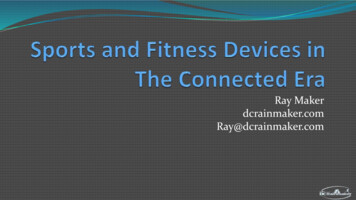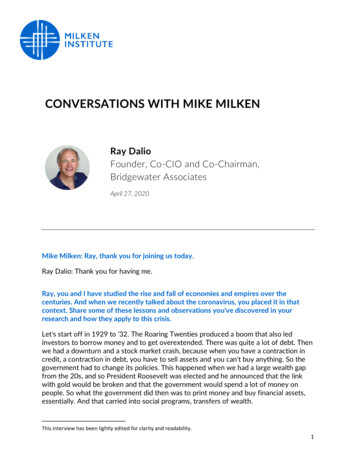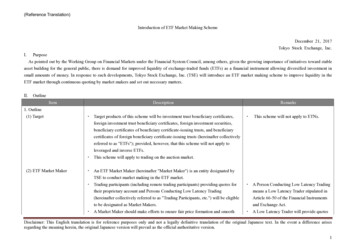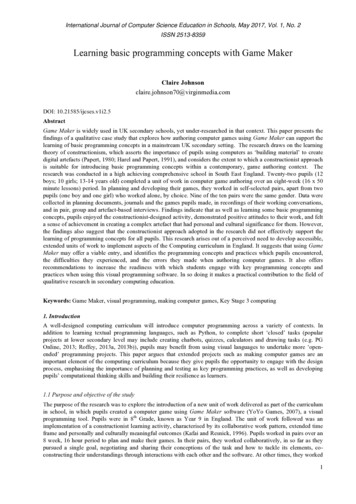
Transcription
Ray Makerdcrainmaker.comRay@dcrainmaker.com
Who exactly am I?By Day: Architect designing enterprise network and datacenter infrastructure for some of theworlds largest organizations based out of Paris, France– travel extensivelyBy Nights and Weekend: Competitive triathlete: Proficient runner, functional cyclist and flailing swimmer (I loveall flotation devices) Completed a few Ironman’s, a few marathons, and a huge pile of far less painful races Love to travel and tinker with gadgets (though my wife would say I just like stockpilingthem) Eat lots of cupcakes (Official Tester in Residence at Bertie’s CupCakery)
Started just over 7 years ago in September 2007Best known for ‘In Depth Reviews’ of Sports Technology productsReviews are the primary initial driver of traffic to siteOver 2.8 Million page views/month, 1.2 Million uniques/monthTens of thousands of daily RSS subscribers including editors for mostmajor sport magazines and gadget sites23K Twitter followers, 33K Facebook FansConsistent growth month over monthRevenue based primarily on affiliate linksNo advertising from product segment I review
Readership here
Who is the reader? From people who don’t know what a HR strap is to those with PhD’s on heart rate technology, aerodynamics engineers, etc Readers are across wide range of levels from Olympic Gold Medalists to thosetrying to lose 300 poundsFollowed by most financial analysts/investment companies watching the sectorMainstream media publications – Washington Post, The Guardian, etc Technology media publications – Engadget, Gizmodo, TechCrunch, etc Television stations – FOX News, etc Sports media publications – Every editor of major pubsAnd finally .you. The companies I review and talk about.
In the beginning There were: Fitness watches Regular cheap watches Fancy high-end watches But many fitness watches still used as regular watches Middle of last decade: Addition of GPS started to carve outnew category, different sized/purpose units You then had a desktop application that uploaded data And last 24 months added phone/WiFi connectivity
The 1st generation of smart watches Smart watches aren’t actually new either, first connected option around 2000, by IBM (with Linux)Then mostly silence, every 3-4 years something showed upAround 2012ish, new resurgence, driven by Kickstarter andprojects like Pebble & MetawatchBut still highly geek-focused, not yet sport/mass-adoptionfocusedWere/are slow, have poor battery, poor displays, not durableAndroid Wear starts to potentially create standardization
List of “Smart Watches” per WikipediaSony SmartWatchSmartWatch 2Samsung Gear LivePebble WatchSamsung Gear 2, Gear Neo, and Gear FitSamsung Gear SSamsung Galaxy GearGarmin ForerunnerNikeFuelWIMM OneMotorola MotoactvMotorola Moto 360MetaWatch StrataTimex DatalinkHOT WatchWearingKreyos MeteorGEAK Watchi'm WatchDigital WEDA (Slap Band)Omate TrueSmartZ1 Android Watch-PhoneFashion S9110LG GD910 (limited edition)Hyundai MB 910ANDROID SmartWatchLG G WatchQualcomm ToqSeiko Ruputer
Fitness folks start doing smart watches First true fitness focused smart watch was the Motorola MotoactvThen we started seeing Garmin get involved (i.e. Fenix lineup)Now Suunto, Timex, Soleus and othersThese watches though were more about notifications than aboutapp development like PebbleThey could effectively do what most 1st gen smart watches coulddo but better.
And then there was a fruit company The Apple Watch: Most feared yet least understoodwatch out there What we know: What it looks like, the screen, appplatform, base price point, requires Apple device What we don’t know: Waterproofing, battery life, fullprice points, connectivity requirements, exact releasedate, how much access apps have to hardware You might be in a better position than you think
More than a watch, it’s a platform Why Apple is different - it’s actually two platforms: Apps on the watch device Health Kit as a health/fitness platform By doing so they complete the ecosystem (and has ‘JustWorks’ factor) Whether or not health/fitness apps will see it as a threatremains to be seen Companies will have to compete on: Hardware / Price /Platforms
Everyone wants a platform Every health/fitnessapp wants to be thatrepository A massive mess ofcompanies with API’s Slightly differentgoals, odd alignmentfor consumers
Platforms don’t equal standardization “A product/system is a standard when it has 80% of the market” - Richard McAinsh (Verve/Infocrank)What is a platform anyway?Rather, platforms just act as landing pads for data, userconnectivity and social interactionEach company now has to normalize dataThere is no data standard for steps, distance, caloriesor sleep
Standardization: The Just Works Factor This is actually why consumers buy most of yourproducts – it works with other things they’re using: Bluetooth Headset, Music The USB plug A SD or CF card for a camera Differences in quality, yes, but core interoperability, no Making examples: No pain, no gain.
Standardization Two core areas of focus for this crowd: File Format Standards Connectivity Standards (using standard profiles correctly) Rule #1: I don’t care about your excuses* Rule #2: Consumers don’t care about your excuses Rule #3: Refer to Rules #1 & #2 *Your excuses will cost you business
Suunto Ambit3 Bluetooth Smart Compatibility
The door swings both ways: ANT Adoption/Creation of profiles is simply taking too long Trainer Profile: Years in the making, no tangible adoption Power Meter High Speed Data: Going to BLE islandsinstead – Stages (or private ANT – Pioneer) Running Dynamics: Scribe Labs, Wahoo TICKR Cycling Dynamics: Could potentially bring clarity to theconfusion of duplicate/non-clear metrics
Standards can change Trying to boil the ocean never really works It doesn’t need to be perfect on the first go, but it doeshave to be interoperable It doesn’t have to encompass everything envisioned,but it should work for those things implemented Companies should be certifying/validating with theirrespective toolsets on ANT and BLE Don’t be the drunk uncle
Starting to see 1st generation devices Two productsthis year: Bia women’sfocused triwatch Timex GPSOne runningwatch
These devices sidestep phone platform issues Not limited to Apple or Android for pairing and data connectivityIdeal for runners, triathletes (less important for cyclists) –no additional carried itemUsually do a better job of keeping all devices on samefirmware levelWill ultimately become the standardHave international roaming agreements (ideal fortravelers)
These devices aren’t perfect though Somewhat limited functionality today Usually a bit bulkier/bigger Have to balance potential layered fees for service Can have battery constraints (though, haven’t seenthat thus far) Susceptible to data usage run-up issues
Power meters and the next few years Last year I said this was “the year of power”. Apparently, I lied. Tremendous price drops over the past 12-18 months Even more over the last 45 days, just the beginning The conversation still needs to shift from watts to ‘what’:Education Consumers hear about power, but 95% don’t understand it Look at how other areas of sport are solving the problem Would ‘Power University’ been more beneficial than ‘CyclingDynamics’?
Activity Trackers Seeing the definition of activity trackers evolve Is a smartwatch that does activity tracking an activitytracker? What about a GPS watch that does it? Used to be just steps/calorie/distance now it’s everything including the kitchen sink I still question the long term viability of standaloneactivity trackers
Action Cameras This market has exploded in the past year Including entrants from the non-usual suspect (HTC?) I’m not 100% convinced that it’s a GoPro only world Sensor data is quickly becoming norm for non-GoPro Seeing potential price divergence however (high and low) Last like year, re-use of this data in a smart manner still toocomplex Record Transfer via USB Translate/Process on Computer Upload to Cloud Service Download to play from cloud service Ride on Trainer
’13-’14: Five products that excited me Here’s five products I’m looking forward to over nextyear. SRM PC8 The ANT Trainer profile Recon Jet Moxy The Garmin FR620 with Running Dynamics
’14-’15: Five products that excite me and whyHere’s five products I’m looking forward to over nextyear. Smaller action cameras with sensors Increased usage/accuracy of optical sensors Better convergence of sport watches smartwatches Apple Watch 4iiii Precision
Biggest Challenges for This Segment Integration across platforms Device pricing versus phone solutions Mobile OS adoption differences for connected devices Sensor compatibility The Apple Watch
Types of reviews ‘First Look’ posts & Initial Hands-On posts Typically trade-show driven posts (not reviews) Last-minute posts, 1-3 days pre-launch (not reviews) Designed to explain product, usually based on prerelease hardware/software In-Depth Reviews Full in-depth review with final product/software
A Typical Test Review Cycle1) Discussions about product, ensuring it’s a proper fit2) Product ArrivesA. Unboxing and initial useB. 4-12 weeks of usage/beating crap out of itC. Information gathering3) Writing the postA. Photos/Content4) PublicationA. Responding to comments (I don’t delete comments)
Ways you can engage with meMethod 1: NDA discussions/product access, farin advance of product release, private betafeedback.Method 2: Product launch timed review. Preavailability product usually under NDA untilpublic announcement.Method 3: Post-release review (already inmarket product). Usually less time sensitive.
Q&A(I’m here till Friday morning)Contact info:Ray@dcrainmaker.comwww.dcrainmaker.comThe Twitter: @dcrainmakerblog
In the beginning There were: Fitness watches Regular cheap watches Fancy high-end watches But many fitness watches still used as regular watches Middle of last decade: Addition of GPS started to carve out new category, different sized/purpose units You then had a desktop application that uploaded data And last 24 months added phone/WiFi connectivity










